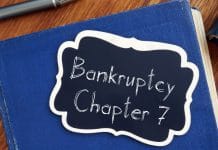Think of Chapter 7 bankruptcy as the “close everything down” option. Unlike Chapter 11, where businesses reorganize and try to keep operating, Chapter 7 means you’re shutting the doors for good. A court-appointed trustee takes over, sells off your business assets, and distributes the money to creditors according to a strict legal hierarchy.
The process is straightforward, relatively quick, and—here’s the kicker—it might be the fresh start you desperately need.
Who Can File for Chapter 7?
Pretty much any business structure can file:
- Corporations (both S-corps and C-corps)
- Limited Liability Companies (LLCs)
- Partnerships (general and limited)
- Sole proprietorships (though this gets tricky since there’s no legal separation between you and your business)
Here’s where it gets interesting: if you’re a sole proprietor, filing Chapter 7 means your personal assets could be on the line. Why? Because legally, you are the business. But if you’ve structured as an LLC or corporation, your personal stuff is typically protected—unless you personally guaranteed business debts.
The Chapter 7 Process: What Actually Happens
Let me walk you through this step-by-step, because understanding the process makes it way less scary.
Step 1: Filing the Petition
Your attorney files the bankruptcy petition with the court. The moment that petition hits the system, something called the “automatic stay” kicks in. This is your breathing room—creditors have to stop all collection activities immediately. No more threatening phone calls, no lawsuits, no repossessions. At least temporarily.
Step 2: Meeting the Trustee
Within a few weeks, you’ll attend a meeting with the bankruptcy trustee (sometimes called the “341 meeting”). The trustee’s job? Figure out what assets your business has and make sure everything’s on the up-and-up. They’ll ask questions about your finances, debts, and assets. Be honest—this isn’t the time for creative accounting.
Step 3: Asset Liquidation
Here’s where things get real. The trustee inventories all your business assets—equipment, inventory, vehicles, real estate, accounts receivable, even intellectual property. Then they sell it all off, usually through auctions or private sales.
What counts as assets? Pretty much everything your business owns:
- Office equipment and furniture
- Inventory and raw materials
- Vehicles and machinery
- Real estate
- Patents, trademarks, and copyrights
- Bank account balances
- Outstanding invoices (accounts receivable)
Step 4: Paying Creditors
The trustee doesn’t just randomly hand out money. There’s a strict pecking order for who gets paid first:
| Priority Level | Creditor Type | Examples |
| 1st | Secured creditors | Banks with collateral, equipment lenders |
| 2nd | Administrative costs | Trustee fees, attorney fees |
| 3rd | Priority unsecured debts | Employee wages (up to $13,650), tax debts |
| 4th | General unsecured debts | Vendors, suppliers, credit cards |
Most general unsecured creditors? They’re lucky if they see pennies on the dollar.
Step 5: Case Closure
Once the trustee sells everything and distributes the funds, the case closes. The business entity is dissolved—it ceases to exist. Game over for that company.
How Long Does Business Bankruptcy Chapter 7 Take?
Most cases wrap up in 4 to 6 months. That’s actually pretty fast compared to other bankruptcy chapters. Complex cases with lots of assets or complicated creditor disputes can stretch to a year, but that’s rare.
The timeline typically looks like this:
- Day 1: File petition, automatic stay begins
- Week 4-6: 341 meeting with trustee
- Month 2-4: Asset liquidation
- Month 4-6: Final distribution and case closure
The Million-Dollar Question: What About Personal Liability?
This is where business structure matters big time.
If You’re an LLC or Corporation
Good news: your personal assets are generally protected. The business is a separate legal entity, so when it goes bankrupt, that’s the end of it. Your house, car, and personal savings stay yours.
But—and this is a huge but—if you personally guaranteed any business debts (which most lenders require), you’re still on the hook for those. Personal guarantees don’t disappear when the business does.
If You’re a Sole Proprietor
Trickier situation. Since you and your business are legally one and the same, Chapter 7 affects both. The good news? You can discharge both business and personal debts. The bad news? Your personal assets aren’t automatically protected.
However, every state has exemption laws that protect certain assets. Commonly protected items include:
- Primary residence (up to certain equity limits)
- One vehicle
- Basic household goods
- Retirement accounts
- Tools of the trade
Managing debt wisely is crucial—whether you’re facing bankruptcy or looking for ways to avoid debt altogether.
Chapter 7 vs. Chapter 11: What’s the Difference?
Think of it this way: Chapter 7 is the exit strategy. Chapter 11 is the survival plan.
Chapter 7:
- Business closes permanently
- Assets liquidated
- Takes 4-6 months
- Costs $1,500-$5,000
- No reorganization plan needed
Chapter 11:
- Business continues operating
- Debts reorganized
- Takes 1-3+ years
- Costs $50,000-$200,000+
- Requires detailed reorganization plan
Chapter 11 makes sense if your business has potential but needs restructuring. Chapter 7 makes sense when the business model isn’t viable anymore or debts are insurmountable.
For business owners, understanding small business tax tips and proper financial planning can sometimes prevent reaching the bankruptcy stage.
What Happens to Your Employees?
Let’s not dance around this—your employees lose their jobs. It sucks, and it’s probably one of the hardest parts of filing Chapter 7.
However, employees have some protections:
- They can file priority wage claims for unpaid salaries (up to $13,650 per person)
- They’re eligible for unemployment benefits
- Unpaid wages and benefits get priority status in the creditor hierarchy
As an employer, you have legal obligations to provide proper notice under the WARN Act if you have 100+ employees.
The Real Cost of Filing Chapter 7
Money talks, so let’s talk numbers.
Court filing fee: $335
Attorney fees: $1,500-$5,000+ (and you legally need an attorney if you’re a business entity)
Trustee fees: Varies based on case complexity and assets liquidated
Total estimated cost: $2,000-$10,000+
Yeah, it’s expensive to go bankrupt. The irony isn’t lost on anyone. But compared to continuing to hemorrhage money with no viable path forward, it’s often the cheaper option long-term.
If you’re struggling with debt before reaching bankruptcy, exploring options like nonprofit debt consolidation or working with debt relief programs might provide alternatives.
Can You Start a New Business After Chapter 7?
Absolutely. Here’s the thing: Chapter 7 dissolves the business entity, not your right to start a new venture.
Once your case closes, nothing legally prevents you from launching a new company under a different entity. However, you’ll face some practical challenges:
- Credit issues: If you personally guaranteed debts or filed personal bankruptcy alongside business bankruptcy, your credit score takes a hit
- Funding difficulties: Lenders and investors will be wary
- Reputation concerns: Suppliers and business partners might be hesitant
But here’s the truth: plenty of successful entrepreneurs have business failures in their past. It’s how you learn and move forward that matters.
Common Myths About Business Bankruptcy Chapter 7
Myth 1: “Filing bankruptcy means I’m a failure”
False. It means you’re making a strategic decision to handle overwhelming debt legally. Some of the most successful business people have filed bankruptcy at some point.
Myth 2: “Creditors can still come after me personally”
Only if you personally guaranteed specific debts. Otherwise, corporate structure protects you.
Myth 3: “I’ll lose everything I own”
Only business assets are liquidated (unless you’re a sole proprietor or have personal guarantees). Your personal property remains yours if properly structured.
Myth 4: “Filing takes years”
Chapter 7 is actually the fastest bankruptcy option—typically 4-6 months.
Myth 5: “I can never borrow money again”
Your credit takes a hit, but you can rebuild. Many people qualify for new credit within a few years.
Alternatives to Consider Before Filing
Chapter 7 isn’t always the only—or best—option. Consider these alternatives:
Debt Settlement
Negotiate directly with creditors to pay less than what’s owed. Can be effective if you have some assets but not enough to cover all debts. Learning how to negotiate credit card debt settlement yourself can save money on third-party negotiators.
Chapter 11 Reorganization
If your business model is solid but you’re buried in debt, Chapter 11 lets you restructure and keep operating.
Out-of-Court Workout
Work directly with creditors to restructure payments without court involvement. Cheaper and faster if creditors cooperate.
Selling the Business
If your business has value, selling it might generate more money than liquidation and give you capital to pay debts.
Simply Closing
If you have minimal assets and debts, sometimes just shutting down and walking away is simpler than formal bankruptcy.
Red Flags That Might Complicate Your Case
The bankruptcy trustee will scrutinize your business dealings before filing. These issues can cause major problems:
Fraudulent transfers: Moving assets to family members or related entities before filing
Preferential payments: Paying certain creditors more than others shortly before filing
Hidden assets: Failing to disclose all business property
Continued business operations: Running up new debts while planning to file
Incomplete records: Poor bookkeeping that raises suspicion
Play it straight. Trustees have seen every trick in the book, and getting caught can result in criminal charges.
Do You Really Need an Attorney?
Short answer: Yes.
Long answer: Federal law requires business entities to be represented by an attorney in bankruptcy court. Sole proprietors can technically file on their own, but it’s a terrible idea.
Bankruptcy law is complex. One mistake on your paperwork can result in your case being dismissed, assets being unnecessarily liquidated, or personal liability you didn’t expect. A qualified bankruptcy attorney knows the system, protects your interests, and handles the mountain of paperwork correctly.
Finding the right legal help is similar to finding a financial advisor for debt—you want someone experienced and trustworthy.
What Debts Survive Chapter 7?
Most business debts are wiped out when the business entity dissolves, but certain obligations can follow you:
- Personal guarantees: You signed personally, you’re still liable
- Fraud-related debts: If you obtained credit through fraud
- Tax debts: Some business taxes transfer to responsible parties
- Student loans: If mixed into business finances
- Child support/alimony: Always survives bankruptcy
- Criminal fines and restitution
Impact on Your Credit and Future
Let’s talk credit damage control. A business Chapter 7 bankruptcy appears on your business credit report for 10 years. If you’re a sole proprietor or personally guaranteed debts, it hits your personal credit for 7-10 years too.
Your credit score will drop—potentially by 150-200 points or more. But here’s the reality: if you’re considering bankruptcy, your credit is probably already struggling from late payments and defaults.
The bankruptcy might actually be your fastest path to credit recovery because it eliminates the debt rather than letting it continue damaging your score month after month.
Moving Forward: Life After Chapter 7
The day your case closes feels surreal. You’re free from the debt, but you’re also probably processing some complicated emotions. That’s normal.
Here’s what comes next:
Rebuild your credit: Start with a secured credit card, make on-time payments, keep balances low
Learn from the experience: What went wrong? What would you do differently?
Plan your next move: New business? Different career? Take time to figure it out
Avoid rushing: Don’t immediately jump into another business venture without proper planning and capital
Seek support: Connect with other entrepreneurs who’ve been through it
Understanding basic financial principles like money management tips and knowing how much money should I have in my checking account helps build a stronger foundation for future ventures.
When Chapter 7 Makes Sense
You should seriously consider filing business bankruptcy Chapter 7 if:
- Your business consistently loses money with no realistic turnaround
- Debts exceed assets by a significant margin
- Creditor lawsuits are pending or threatened
- You’re using personal funds to keep the business afloat
- The business model is no longer viable
- You want a clean break to start fresh
You might want to explore alternatives if:
- The business is temporarily struggling but fundamentally sound
- You have significant assets you’d like to protect
- Most debts are personally guaranteed anyway
- You’re close to paying off major debts
- Market conditions are temporarily unfavorable but improving
Important Considerations for Different Business Types
Corporations and LLCs
Your corporate veil protection is strongest here. The business entity absorbs the bankruptcy, and you walk away clean—assuming no personal guarantees. Make sure your corporate formalities have been properly maintained (regular meetings, separate finances, proper documentation), or creditors might try to “pierce the corporate veil.”
Partnerships
Each partner’s liability depends on the partnership structure. In a general partnership, partners have unlimited personal liability. Limited partners have more protection. Either way, make sure all partners are on the same page before filing.
Sole Proprietorships
You’re filing personal bankruptcy that includes business debts. This means using personal bankruptcy exemptions to protect assets. Consult with your attorney about which assets qualify for protection under your state’s laws.
Final Thoughts: This Isn’t the End
Filing business bankruptcy Chapter 7 feels like defeat, but it’s actually a strategic legal tool that humans created specifically to handle overwhelming debt. It’s not a moral failing—it’s a business decision.
The American economy is built on entrepreneurship, risk-taking, and yes, sometimes failure. Bankruptcy exists because we recognize that economic freedom includes the freedom to start over when things don’t work out.
Will it be easy? No. Will you face challenges rebuilding? Absolutely. But you’ll also be free from crushing debt that was preventing you from moving forward.
Thousands of business owners file Chapter 7 every year. Many go on to start new, more successful ventures. Some choose different career paths. All of them move forward.
Whatever you decide, make it an informed decision. Consult with a qualified bankruptcy attorney, understand your options, and choose the path that makes the most sense for your situation.
The door on this business might be closing, but plenty of other doors are waiting to open.
Ready to explore your options? Don’t face this alone. Consult with a bankruptcy attorney who can review your specific situation and guide you through the process. The consultation is often free, and the peace of mind is priceless.
For more financial guidance and resources, visit Wealthopedia.
Disclaimer: This article is for informational purposes only and does not constitute legal or financial advice. Bankruptcy law varies by state and individual circumstances. Always consult with a qualified bankruptcy attorney before making decisions about filing for bankruptcy.

























